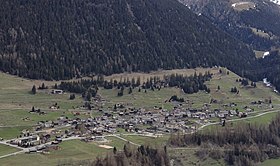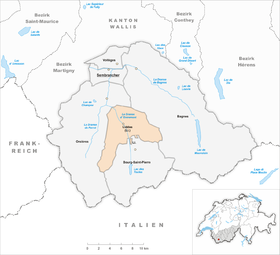Liddes
| Liddes | |
|---|---|
| State : |
|
| Canton : |
|
| District : | Entremont |
| BFS no. : | 6033 |
| Postal code : | 1945 |
| Coordinates : | 580391 / 93447 |
| Height : | 1346 m above sea level M. |
| Height range : | 986–3662 m above sea level M. |
| Area : | 58.65 km² |
| Residents: | 720 (December 31, 2018) |
| Population density : | 12 inhabitants per km² |
| Website: | www.liddes.ch |
|
Liddes |
|
| Location of the municipality | |
Liddes is a political municipality and a civil parish in the Entremont district in the French-speaking part of the canton of Valais in Switzerland .
geography
The community is located on the main road 21 to the Great St. Bernard as the second last village before the top of the pass. It borders Orsières to the north, Bagnes to the east and Bourg-Saint-Pierre to the south and, in addition to Liddes-Ville, consists of the hamlets of Chandonne, Dranse, Rive-Haute, Fontaine-Dessous, Fontaine-Dessus, Les Moulins, Vichères, Fornex, Chez-Petit and Palasuit .
history
The archaeological research of 2014 at the Mur d'Annibal at around 2640 m above sea level. M. above Liddes (top wall: 584 064 / 92652 ; end wall: 584 168 / 92602 ) the local finds dated v at the time of 50-15. BC This is likely to be the highest point with traces of settlement from this era in Europe.
Liddes was first mentioned in 1177 as Leides . It was owned by the Bishop of Sitten until 1475 when it passed to the House of Savoy . The feudal rights of the Allinges family were already in 1376 to Amadeus VI. passed over from Savoy . The community emerged from a split from Orsières in 1228 and gained its freedoms in 1308. During the Helvetic Republic it belonged to the short-lived Rhodan Republic , which was planned to secure the Simplon and Great St. Bernhard passes , then to the Republic of Valais and from 1810 to 1814 to the French department of Simplon . The march through of the French reserve army in 1800 forced many of the impoverished residents to emigrate.
The church of St. George was the refectory of the Bishop of Sion, who gave it to the order of the Great St. Bernard in the 12th century . From the 15th century, each hamlet had its own chapel.
The majority of the residents, who work in agriculture and the timber industry, formed alpine and agricultural cooperatives. Some worked as day laborers in the vineyards of Martigny , Aigle and Bex . From 1899, the municipality received concession fees ( water interest ) according to the hydropower potential of the tributaries of the Rhone used on its territory . The district of Vichères-Bavon has developed into a winter health resort and ski area since 1974.
population
| Population development | |||||||||
|---|---|---|---|---|---|---|---|---|---|
| year | 1802 | 1850 | 1900 | 1950 | 2000 | 2010 | 2012 | 2014 | 2016 |
| Residents | 1243 | 1347 | 1076 | 720 | 659 | 750 | 729 | 752 | 755 |
The population development had steadily declined since the 19th century and has been recovering since 2004: 1802 1,243 inhabitants; 1850 1,347; 1900 1,076; 1950 720; 2000 659; 2010 750; 2012 729.
Attractions
literature
- Albano Hugon: Liddes. In: Historical Lexicon of Switzerland . 2008 .
Web links
- Liddes on the ETHorama platform
- Official website of the municipality of Liddes
- Preliminary report on the "Etruscan script" and the "Mur d'Annibal" by Liddes VS, 2007
- A Théo Lattion: L'énigme du Mur d'Annibal ("The riddle of the Mur d'Annibal")
Individual evidence
- ↑ Permanent and non-permanent resident population by year, canton, district, municipality, population type and gender (permanent resident population). In: bfs. admin.ch . Federal Statistical Office (FSO), August 31, 2019, accessed on December 22, 2019 .
- ↑ Recherches Archéologiques du mur (dit) d'Hannibal
- ↑ Urs Schwegler: Preliminary report on the "Etruscan script" and the "Mur d'Annibal" by Liddes , 2007, page 3
- ↑ Le Nouvelliste of February 2, 2014: L'Entremont fête 40 ans de ski sur les hauts de Liddes





